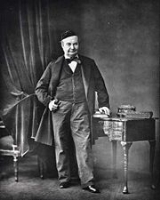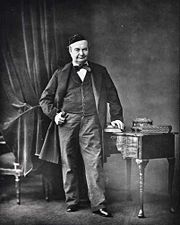
Charles Augustin Sainte-Beuve
Encyclopedia
- Saint Beuve redirects here. For the eponymous saint, see Beuve, Abbess of Saint Pierre de ReimsBeuve, Abbess of Saint Pierre de ReimsSaint Beuve and her brother Balderic lived in the 7th century in France. They were reputed to be children of Sigebert I or Sigebert II, king of Austrasia, based on oral tradition recorded by Flodoard, Canon of Reims, three centuries later...
.

Charles Augustin Sainte-Beuve (23 December 1804 in Boulogne-sur-Mer
Boulogne-sur-Mer
-Road:* Metropolitan bus services are operated by the TCRB* Coach services to Calais and Dunkerque* A16 motorway-Rail:* The main railway station is Gare de Boulogne-Ville and located in the south of the city....
– 13 October 1869 in Paris
Paris
Paris is the capital and largest city in France, situated on the river Seine, in northern France, at the heart of the Île-de-France region...
) was a literary critic and one of the major figures of French literary history
French literature
French literature is, generally speaking, literature written in the French language, particularly by citizens of France; it may also refer to literature written by people living in France who speak traditional languages of France other than French. Literature written in French language, by citizens...
.
Early years
He was born in BoulogneBoulogne-sur-Mer
-Road:* Metropolitan bus services are operated by the TCRB* Coach services to Calais and Dunkerque* A16 motorway-Rail:* The main railway station is Gare de Boulogne-Ville and located in the south of the city....
, educated there, and studied medicine at the Collège Charlemagne in Paris
Paris
Paris is the capital and largest city in France, situated on the river Seine, in northern France, at the heart of the Île-de-France region...
(1824-27). In 1828, he served in the St Louis Hospital. Beginning in 1824, he contributed literary articles, the Premier lundis of his collected Works, to the Globe
Le Globe
Le Globe was a French newspaper, published between 1824 and 1832, created with the goal of publishing Romantic creations. It was established by Pierre Leroux. After 1828, the paper became political and Liberal in tone....
newspaper, and, in 1827, he came, through a review of Victor Hugo's
Victor Hugo
Victor-Marie Hugo was a Frenchpoet, playwright, novelist, essayist, visual artist, statesman, human rights activist and exponent of the Romantic movement in France....
Odes et ballads, into close association with Hugo and the Cénacle
Cénacle
Cénacle is the name given to a Parisian literary group of varying constituency that began about 1826 to gather around Charles Nodier. The group sought to revive in French literature the old monarchical spirit, the spirit of mediæval mystery and spiritual submission. The chief members were Vigny...
, the literary circle that strove to define the ideas of the rising Romanticism
Romanticism
Romanticism was an artistic, literary and intellectual movement that originated in the second half of the 18th century in Europe, and gained strength in reaction to the Industrial Revolution...
and struggle against classical formalism
Formalism (literature)
Formalism is a school of literary criticism and literary theory having mainly to do with structural purposes of a particular text.In literary theory, formalism refers to critical approaches that analyze, interpret, or evaluate the inherent features of a text. These features include not only grammar...
. Sainte-Beuve became friendly with Hugo after publishing a favourable review of the author's work but later had an affair with Hugo's wife, which, naturally enough, led to their estrangement. Curiously, when Sainte-Beuve was made a member of the French Academy
Académie française
L'Académie française , also called the French Academy, is the pre-eminent French learned body on matters pertaining to the French language. The Académie was officially established in 1635 by Cardinal Richelieu, the chief minister to King Louis XIII. Suppressed in 1793 during the French Revolution,...
in 1845, the ceremonial duty of giving the reception speech fell upon Hugo.
Career
Sainte-Beuve published collections of poems and the partly autobiographical novelAutobiographical novel
An autobiographical novel is a form of novel using autofiction techniques, or the merging of autobiographical and fiction elements. The literary technique is distinguished from an autobiography or memoir by the stipulation of being fiction...
Volupté in 1834. His articles and essays were collected the volumes Port-Royal and Portraits littéraires.
During the turmoil of 1848 in Europe
Revolutions of 1848
The European Revolutions of 1848, known in some countries as the Spring of Nations, Springtime of the Peoples or the Year of Revolution, were a series of political upheavals throughout Europe in 1848. It was the first Europe-wide collapse of traditional authority, but within a year reactionary...
, he lectured at Liège on Chateaubriand et son groupe littéraire. He returned to Paris in 1849 and began his series of topical columns, Causeries du lundi ('Monday Chats') in the newspaper, Le Constitutionnel
Le Constitutionnel
Le Constitutionnel was a French political and literary newspaper, founded in Paris during the Hundred Days by Joseph Fouché. Originally established in October 1815 as The Independent, it took its current name during the Second Restoration. A voice for Liberals, Bonapartists, and critics of the...
. When Louis Napoleon became Emperor, he made Sainte-Beuve professor of Latin poetry at the Collège de France
Collège de France
The Collège de France is a higher education and research establishment located in Paris, France, in the 5th arrondissement, or Latin Quarter, across the street from the historical campus of La Sorbonne at the intersection of Rue Saint-Jacques and Rue des Écoles...
, but anti-Imperialist students hissed him, and he resigned.
Port-Royal
After several books of poetry and a couple of failed novels, Sainte-Beuve began to undertake literary research, of which the most important is Port-Royal. He continued to contribute to La Revue contemporaine.Port-Royal (1837-1859), probably Sainte-Beuve's masterpiece, is an exhaustive history of the Jansenist
Jansenism
Jansenism was a Christian theological movement, primarily in France, that emphasized original sin, human depravity, the necessity of divine grace, and predestination. The movement originated from the posthumously published work of the Dutch theologian Cornelius Otto Jansen, who died in 1638...
abbey of Port-Royal-des-Champs. It not only influenced the history of religious belief
Religious belief
Religious belief is a strong belief in a supernatural power or powers that control human destiny. Such a state may relate to the existence, characteristics and worship of a deity or deities, divine intervention in the universe and human life, or values and practices centered on the teachings of a...
, i.e., the methodology of such research, but also the philosophy of history
Philosophy of history
The term philosophy of history refers to the theoretical aspect of history, in two senses. It is customary to distinguish critical philosophy of history from speculative philosophy of history...
and the history of esthetics.
He was made Senator in 1865, in which capacity he distinguished himself by his pleas for freedom of speech
Freedom of speech
Freedom of speech is the freedom to speak freely without censorship. The term freedom of expression is sometimes used synonymously, but includes any act of seeking, receiving and imparting information or ideas, regardless of the medium used...
and of the press. According to Jules Amédée Barbey d'Aurevilly
Jules Amédée Barbey d'Aurevilly
Jules-Amédée Barbey d'Aurevilly was a French novelist and short story writer. He specialised in mystery tales that explored hidden motivation and hinted at evil without being explicitly concerned with anything supernatural...
, "Sainte-Beuve was a clever man with the temper of a turkey!" In his last years, he was an acute sufferer and lived much in retirement.
One of Sainte-Beuve's critical contentions was that, in order to understand an artist and his work, it was necessary to understand that artist's biography. Marcel Proust
Marcel Proust
Valentin Louis Georges Eugène Marcel Proust was a French novelist, critic, and essayist best known for his monumental À la recherche du temps perdu...
took issue with this notion and refuted it in a set of essays, Contre Sainte-Beuve ("Against Sainte-Beuve"). Proust developed the ideas first voiced in those essays in À la recherche du temps perdu
In Search of Lost Time
In Search of Lost Time or Remembrance of Things Past is a novel in seven volumes by Marcel Proust. His most prominent work, it is popularly known for its considerable length and the notion of involuntary memory, the most famous example being the "episode of the madeleine." The novel is widely...
.
Works
- Tableau de la poésie française au seizième siècle (1828)
- Vie, poésies et pensées de Joseph Delorme (1829)
- Les Consolations (1830) (poetry)
- Volupté (1835) (novel)
- Port-Royal (1840–1859)
- Les Lundis (1851–1872)
- Causeries du lundi, 15 vols. (1851–1862)
- Nouveaux Lundis (1863–1870)
In English
- English Portraits (NY: Holt, 1875), a selection from Causeries du lundi'
- William Sharp, ed., William Matthews and Harriet W. Preston, translators, Essays on Men and Women (London, 1890)
- E. J. Trechmann, trans., Causeries du lundi, 8 vols. (New York, 1909-11)
Sources
- Harold George Nicolson, Sainte-Beuve (London: Constable, 1957)
- Roger L. Williams, Gaslight and Shadow: The World of Napoleon III (NY: Macmillan, 1957), Ch. 5: "Sainte-Beuve, Sultan of Literature"
External links
- What Is a Classic? at Bartleby.com

